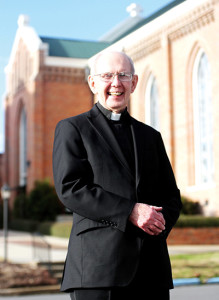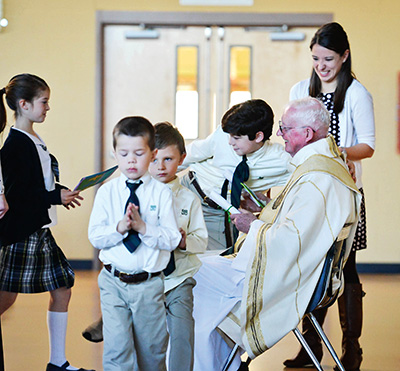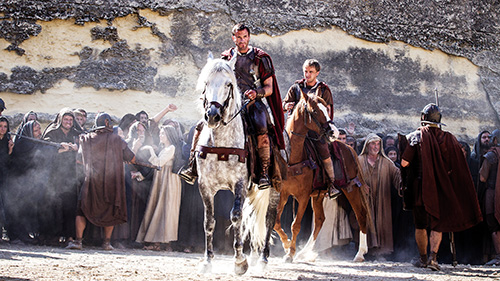By Bill Graham
City Editor, The Meridian Star
When Frank Cosgrove came to Mississippi more than 50 years ago, he saw some things he didn’t like.
The 24-year-old arrived in 1965, in the middle of the civil rights movement.
“It was a rude awakening, because I didn’t really know anything about it,” he recalls. “But I learned soon, because I experienced it a few times, and that really taught me a lot. For example, I got refused service in a restaurant because I had a group of black and white teenagers with me.”

Father Frank Cosgrove retired at the end of January after 11 years as pastor of Meridian St. Patrick and St. Joseph parishes. He resides at St. Catherine’s Village in Madison. (Photo courtesy of The Meridian Star)
Experiences like that led Father Cosgrove to seek more inclusion in his life’s work as a priest, which is one of the reasons he is the 2016 Meridian Star Citizen of The Year.
He was born in the County of Leitrim in Ireland on Oct. 7, 1940. He was the oldest of three children and was educated at Summerhill College in Sligo, Ireland and St. Patrick Seminary in Carlow, Ireland.
He chose to come to Mississippi for several reasons.
“The Catholic population in Mississippi was small — only about three percent,” he recalled. “I wanted to come to a place where I was needed. Ireland had plenty priests at the time. And I guess I liked the adventure. It was sort of like being a missionary.”
Father Cosgrove was ordained a priest by the Diocese of Jackson on June 12, 1965, and was first assigned to St. Mary Basilica in Natchez. He then moved to Oxford where he became pastor at St. John Parish and was appointed the Catholic minister to the University of Mississippi.
At one time, he was in charge of youth program for the entire diocese, which covered all of Mississippi at the time.
After he left Oxford, he spent 11 years as the pastor at St. Francis Parish in Madison. In 2005, he came to Meridian to serve the Catholic Community, which includes St. Joseph and St. Patrick parishes, along with the Naval Air Station Meridian and Good Shepherd Mission in Quitman. Father Cosgrove retired at the end of January after 11 years here.
He remembers getting a warm welcome when he came to Meridian.
“My first Sunday at St. Joseph’s, one parishioner told me ‘Father, you’re in the right place,’” and the folks at St. Patrick’s were equally as welcoming.”
“Transfers are not easy for us guys,” Father Cosgrove says of the process by which priests are appointed. “But they welcomed me so well. I fit in really quickly.”
In Meridian, as in the other places he lived, he worked hard to take his faith beyond the church walls.
“I’ve always done that, no matter where I was,” he said. “In all my other appointments, I was the same way. I like to be involved in the larger community.”
That meant he once spent four days on an aircraft carrier with sailors from NAS Meridian.
“That was a good experience, but once was enough,” he said with a chuckle.
He also worked with Habitat for Humanity and other service organizations in improving the community.
He also saw enrollment grow at St. Patrick Catholic School during his tenure. The school expanded by opening a new building last May, and plans to welcome its first class of eighth graders this fall.
“I love the Christian values and high academic standards at St. Patrick,” he said. “And of course, it’s open to people of all faiths and races.”
In retirement, Father Cosgrove has settled in at St. Catherine’s Village in Madison.
“I’ve been mainly unpacking,” he said. “And getting furniture, which is something I’ve never had to do before because the church always provided us with a furnished home.”
He plans to work “as needed,” filling in for other priests when they need a break.
“Already I’m booked a couple of Sundays,” he said. “But the difference is, it’s up to me now.”
And although he lives in Madison, he plans to visit Meridian when he can.
“I miss Meridian a lot,” Father Cosgrove said. “I miss the relationships with the parishioners and the community — deep relationships on a spiritual level.”
“We’re there for very special occasions in peoples’ lives, births, baptisms, weddings and funerals. God’s grace really works through us there.”
Looking back at more than a half century of ministry, he hopes his work has been fruitful.
“Certainly, race relations have improved,” he said. “But we still have a long way to go. There’s still a lot of underlying racism, I’m afraid. But I’m pleased with the progress we made.”

Msgr. Michael Flannery receives farewell cards from St. Anthony School students after celebrating Mass at the school. He retired in January and is working for the Tribunal, helping with annulments. (Photo by Dave Vowell)
“The goal is always to bring people to Jesus Christ, and to bring Christ to people. So that’s what my goal has been. I guess I’ve done it in different ways, whether it was with teenagers, college students, or with older people. But whatever goals I accomplished, it was through God’s grace. And I’m not just being pious about that, I really feel it.”
“By the grace of God, I am what I am,” Father Cosgrove noted. “That’s the only way I can do anything.”
(Reprinted with kind permission from The Meridian Star)

